野猪Wild Boar
1. 分类Taxonomy
偶蹄目Artiodactyla
猪科Suidae
猪属Sus
野猪Sus scrofa(Linnaeus,1758);英文名Wild Boar、Eurasian Wild Pig、Ryukyu Islands Wild Pig
2. 保护级别Conservation Assessment
l 我国三有保护物种,指有益的、有重要生态价值、有科学研究价值的野生动物
Beneficial, ecologically important and scientifically valuable wildlife under protection of China
l IUCN红色名录低危物种;
Least Concerned species on IUCN Red List
3. 形态特征Physical Description
野猪是家猪的祖先。
身体体长90-180厘米;肩高59-109 厘米;体重50-200千克。
身材矮胖,体色褐色或略带黑色,不同地区的野猪毛发颜色也不一样。毛很粗,成年个体从头顶到颈后有一条毛脊(图1)。北方的野猪毛较长,而热带地区的野猪毛较稀疏。幼仔体表有棕色和浅黄色相间的纵向条纹(图2),并随年龄的增长在第一年中逐渐消失。
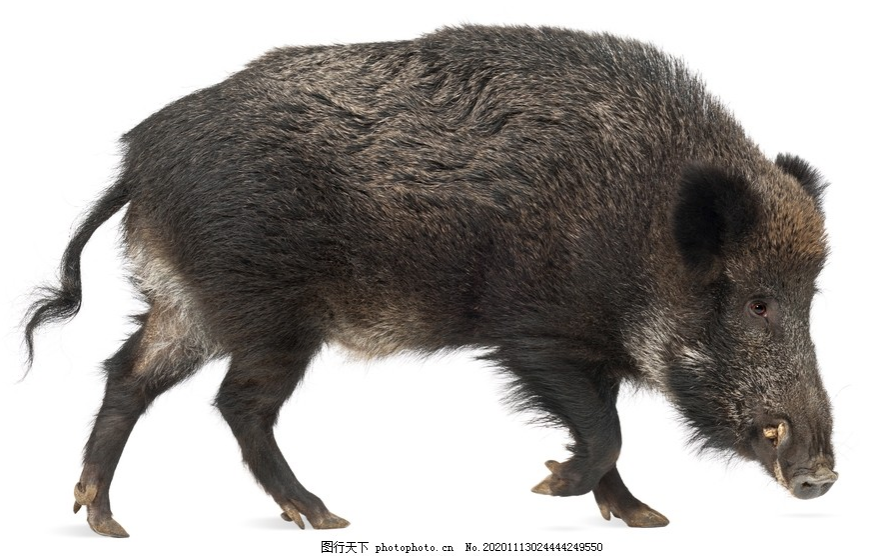
图1. 成年野猪实物图(来源图行天下photophoto.cn)
Figure 1. Wild boar adult (origin: photophoto.cn)
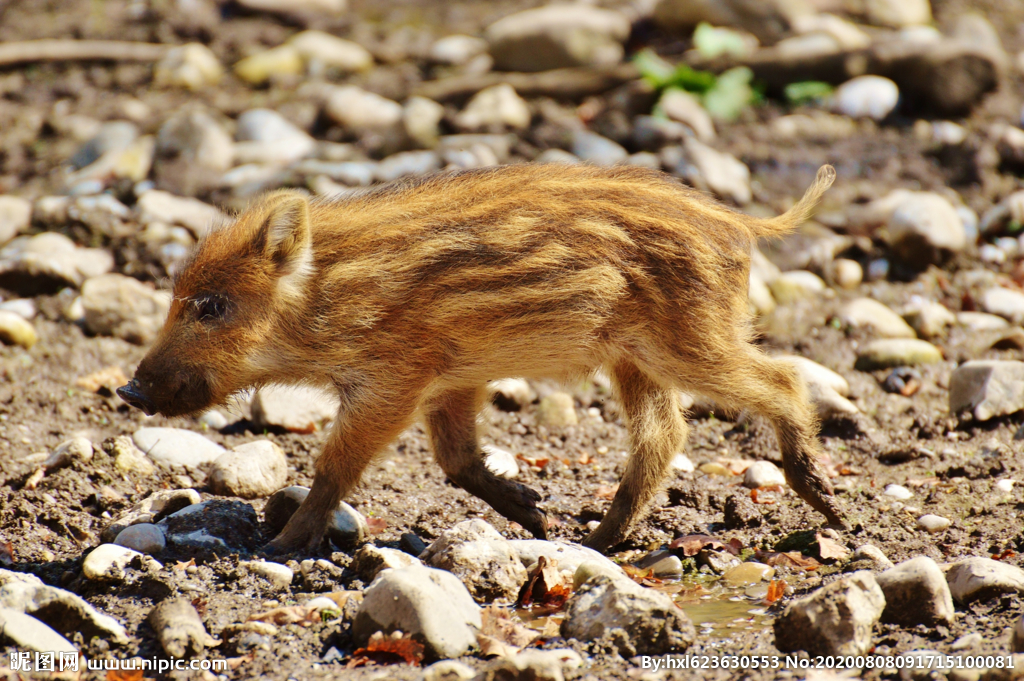
图2. 野猪幼仔实物图(作者:hxl623630553,来源昵图网www. nipic. com)
Figure 2. Wild boar cub (Contributor: hxl623630553: origin: www. nipic. com)
头较长,耳小并直立。吻部突出似圆锥体,其顶端为裸露的软骨垫(即拱鼻)(图3)。野猪的拱鼻十分坚韧有力,可以用来挖掘洞穴或推动40-50千克的重物,或当作武器。野猪的嗅觉特别灵敏,它们可以用鼻子分辨食物的成熟程度。甚至可以搜寻出埋于厚度达2米的积雪之下的一颗核桃。雄兽还能凭嗅觉来确定雌兽所在的位置。
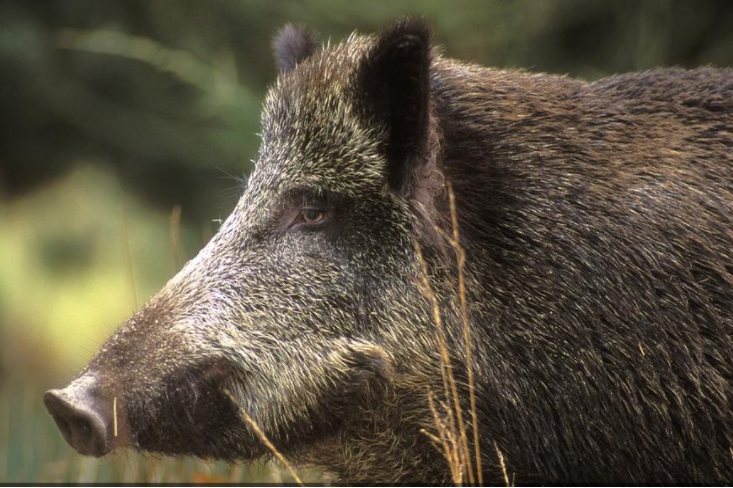
图3. 野猪头部图示鼻子(作者:Vilda - Rollin Verlinde,来源IUCN)
Figure 3. The arched snout of wild boar (contributor: Vilda - Rollin Verlinde; origin: IUCN)
成年雄性下犬齿显著延长且粗壮外翻,形成獠牙,用于防卫和进攻(图4)。
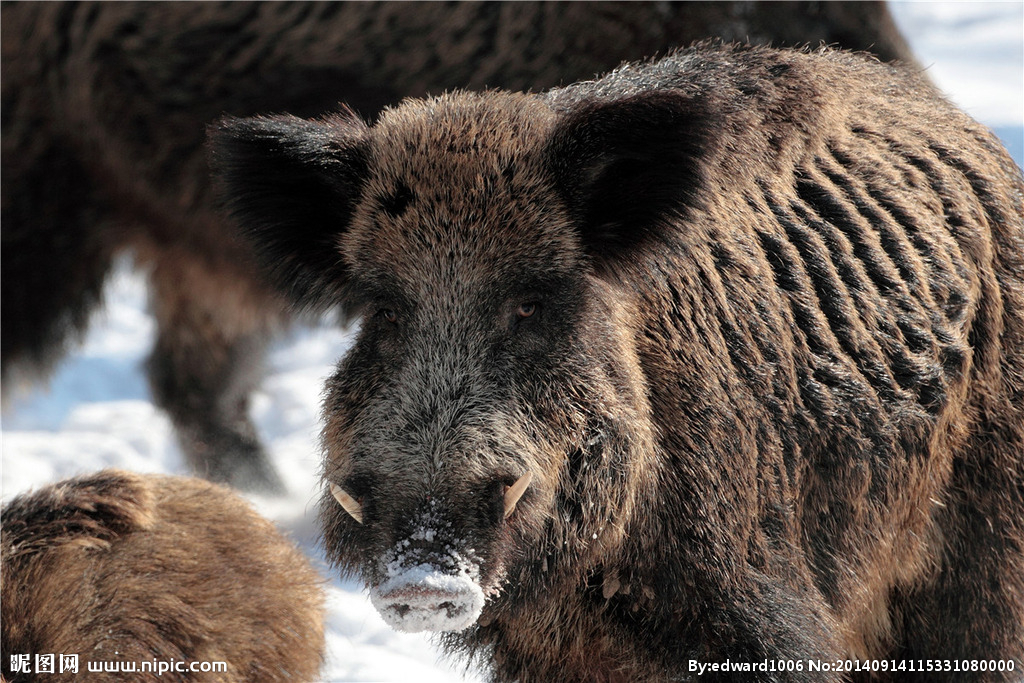
图4. 野猪实体图示雄性獠牙(作者:edward1006,来源昵图网www. nipic. com)
Figure 4. The tusks of male wild boar (contributor: edward1006; origin: www. nipic. com)
The wild boar is the ancestor of the domestic pig.
Body length: 90-180 cm; Shoulder height: 59-109 cm; Weight: 50-200 kg.
Boars are squat in body shape and brown or slightly black in color, and the color of their hair varies from region to region. The hair is coarse, and adults have a hair ridge running from the top of the head to the back of the neck (Fig. 1). Wild boars in the north have longer hair, while those in the tropics have less hair. Cubs have longitudinal stripes of brown and light yellow on their body surface (Fig. 2), which gradually disappear during the first year with age.
Wild boars have long head, small and erect ears. The snout protrudes like a cone, capped by a bare cartilaginous pad (the arched snout) (Fig. 3). The arched snout is so strong that it can be used for burrowing, pushing things weighing 40-50kg, or as a weapon. Wild boars have a very acute sense of smell, and they can tell the ripeness of food with their noses. They can even find a walnut buried under two meters of snow. Males can also use their sense of smell to locate females.
Two of the lower canine teeth of adult males are significantly elongated and extruded, forming tusks for defense and attack (Fig. 4).
4. 地理分布Geographic Range
在世界范围内,野猪广泛分布于欧亚大陆、靠近大陆的岛屿以及非洲西北部一小片区域(图5),并被人为引入到除南极洲以外的各大陆。是全世界所有陆生兽类中分布范围最广的物种之一。
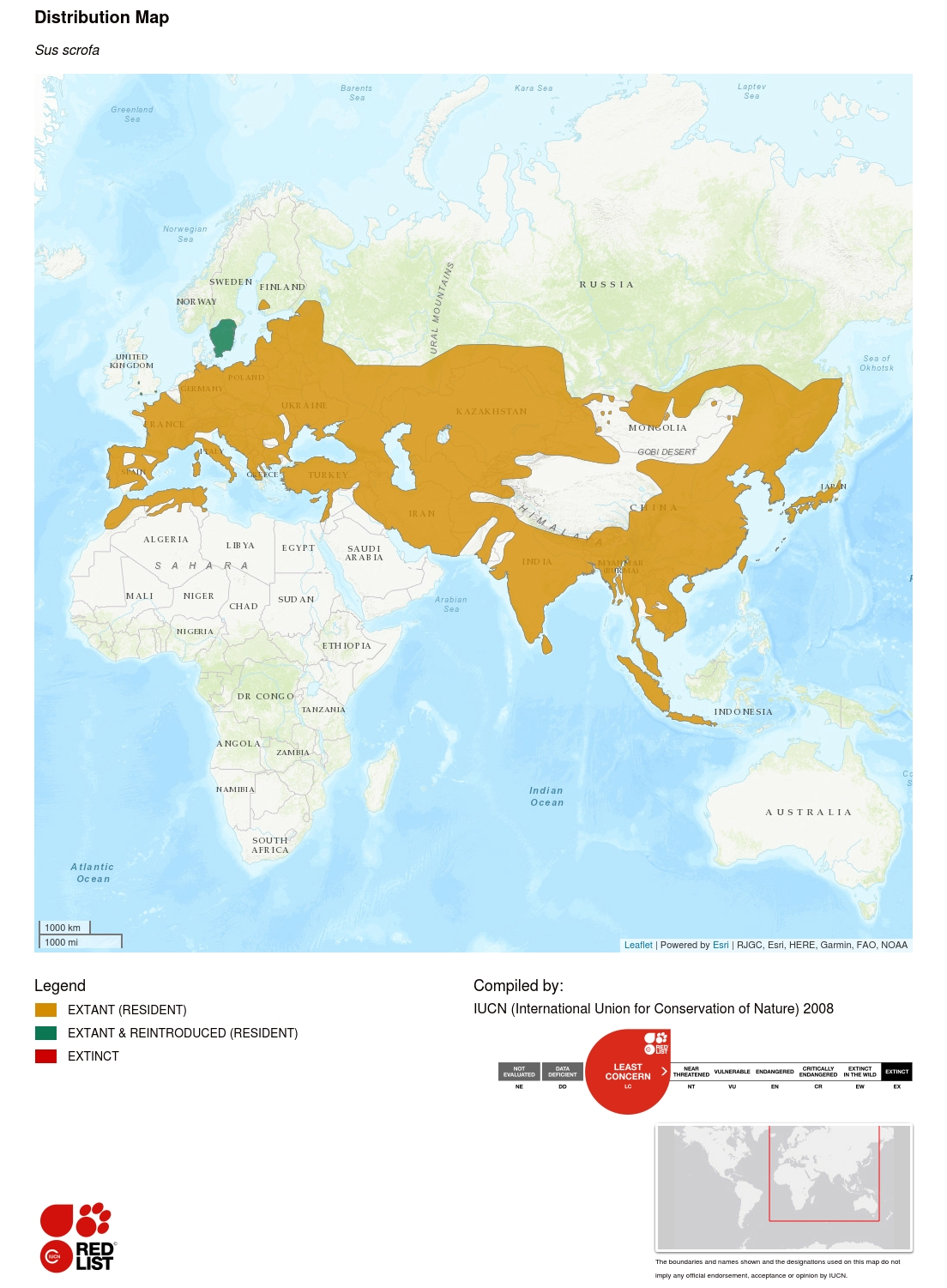
图5. 野猪世界范围分布(来源IUCN)
Figure 5. Geographic range of wild boar around the world (origin: IUCN)
在中国,除了干旱荒漠和高原区外均有分布(图6)。

图6. 中国野猪分布(作者阳光兽医,来源阳光畜牧网)
Figure 6. Geographic range of wild boar in China (contributor: yangguangshouyi; origin: ygsite.cn)
Worldwide, wild boars are widely distributed in Eurasia, islands close to the continent, and a small area of northwest Africa (Fig. 5), and have been artificially introduced to every continent except Antarctica. It is one of the most widely distributed of all land mammals in the world (Fig. 5).
It is widely distributed in China except in arid desert and plateau areas (Fig. 6).
5. 栖息环境Habitat
野猪适应性很强,几乎在所有野外栖息地都能被发现,从森林到灌丛,从草地到沼泽,并侵入农地,其范围还深入到山区。
Wild boars are highly adaptable and can be found in almost all types of habitats, such as forests, thickets, grasslands, swamps. And they will invade agricultural land, and go deep into mountainous areas.
6. 生活习性Ecology
6.1 食物Food Habits
杂食动物,吃植物、菌类、种子和果实,特别喜欢坚果类,也吃蠕虫、蜗牛、昆虫、小型脊椎动物和腐肉。
在进食时用它扁平而敏感的鼻子乱翻土壤的表层,嗅出美味食物。野猪也能成为捕食者,有时会攻击遇到的蛇类。
Wild boars are omnivores feeding on plant, fungi, seeds, and fruits, especially nuts, but also worms, snails, insects, small vertebrates, and carrion.
Its flat, sensitive nose digs the surface of the soil to sniff out food. Wild boars can also be predators, sometimes they will attack snakes they encounter.
6.2 社群Sociality
野猪是一种好集群的偶蹄类动物, 虽然有些雄性单独生活,但野猪通常是集小群活动,如海南岛的野猪多3-5头一起觅食,在同一采食范围内各有各的采食点,一般不集成大群。
为适应其繁殖、觅食的需要,野猪会形成大小不等的群体。影响野猪集群的因素有气候、食物、天敌和人类活动。
The wild boar is highly social artiodactyls. Although some males live alone, the wild boar usually gathers in small groups. For example, the wild boar in Hainan Island usually has 3-5 members foraging together and has different feeding sites within the same feeding range. They usually don’t form large group.
To meet the needs of reproduction and foraging, wild boars will form groups of different sizes. Factors that affect wild boar clusters are climate, food, natural enemies, human activities, and etc .
6.3 家域Home Range
野猪的家域大小因几个因素而异,包括群体中的个体数量、食物资源的可用性、地理分布和捕食者威胁。雌性往往占据较小的区域,并保持在一个家庭范围内的覆盖区域,以保护自己和孩子。雌性群体可接受同其它群体之间家域的一些重叠。雄性倾向于占据更大的区域。它们可以容忍与其它雄性的活动范围重叠,但在交配季节,它们会变得更有领域意识,因为它们准备争夺繁殖权。
野猪的平均领域面积为1.1- 3.9平方千米。
Home range sizes of wild boars vary based on several factors, including the group size, availability of food resources, geographic distribution, and predators. Females tend to occupy smaller areas and stay within a family-wide coverage area to protect themselves and their young. Females can accept some overlap with other populations. Males tend to occupy larger areas. They can tolerate overlapping ranges with other males, but become more territorial during mating season as they prepare to compete for reproduction.
The average area of the wild boar ranges from 1.1 to 3.9 km2.
6.4 节律Rhythm
主要在黄昏和夜晚活动。野猪在吃和睡上要花许多时间。
Wild boar are mainly active at sunset and night. They spend lots of time eating and sleeping.
6.5 移动Moving Method
野猪善于游泳。
Wild boars are good at swimming.
6.6 其它Others
野猪喜欢在泥水中洗浴。
雄兽还要花好多时间在树桩、岩石和坚硬的河岸上磨擦它的身体两侧,这样就把皮肤磨成了坚硬的保护层,可以避免在发情期的搏斗中受到重伤。
Wild pigs like to wallow in muddy water.
The male also spends much time rubbing his sides against tree stumps, rocks, and hard riverbanks, thus grinding his skin into a hard protective layer that will protect him from serious injuries in a fight during mating seasons.
7. 繁殖Reproduction
野猪是“一夫多妻”制。发情期雄兽之间要发生一番争斗,胜者占据统治地位,获得与雌性的交配权。
野猪的孕期只有4个月,每胎4-8仔,而且在繁殖旺盛期的雌兽,一年能生2胎,一般在春季4-5月间生一胎,秋季又有另一胎出生。
雌兽通常在将要分娩的几天前就开始寻找合适的位置做“育儿巢”。育儿巢的位置一般选在隐蔽处,它们叼来树枝和软草,铺垫成一个松软舒适的育儿巢,以便为刚出生的“儿女们”遮风挡雨。幼仔刚出生的时候就有4个长牙。2个星期后便能够咬吃东西。雌兽在前面开路,幼仔紧跟在它的后面,在雌兽挖成的沟里寻找食物。在幼仔尚小的时候,雌兽单独照顾幼仔。这时的雌兽攻击性很强,甚至连雄兽也害怕它。幼仔生长几个星期以后.雌兽的脾气才有所改变。
小野猪在出生的头一年中,体重能增加l00倍。这种生长速度在脊椎动物中是很少见的。
Wild boars are polygamous. There are fights between males during mating seasons, and the winner takes over and gets the right to mate with the female.
The pregnancy period of wild boar is only 4 months, and litter size is 4-8. The female animals in the highly fertile age can reproduce twice a year, one in April and May in spring, and another in autumn.
Females usually search for a suitable place to build a "nursery nest" several days before they are due to give birth. The nursery nest is usually located in a hidden place, and they bring branches and soft grass to form a soft and comfortable nursery nest, so as to provide shelter for their newborns. The cubs are born with four teeth. After 2 weeks, they can bite and eat. The female leads the way, and her young follow close behind, searching for food in the trench she has dug. The female takes care of her young alone when they are young. The female in nursing is so aggressive that even the male is afraid of her. After a few weeks of cubs’ growth. The female's temper changed.
In the first year of life, cubs can gain 1, 000 times their original weight. This rate of growth is unusual in vertebrates.
8. 天敌及御敌策略Predators and Defense Strategies
野猪的天敌有狼、熊、豹、猞猁、猛禽等野生动物。野猪机灵凶猛,奔跑快速,警惕性也很强。身上的鬃毛既是保暖的“外衣”,又是向同伴发出警告的报警器,一旦遇到危险。它会立即抬起头,突然发“哼”声,同时鬃毛都会倒竖起来。即使是豹子遇到野猪群,也不敢贸然发动进攻。大多数老弱病残的野猪是野生动物首选猎捕的对象,这是生态平衡自然调节不可缺少的一环,事实上这有利于野猪种群的优化。
有的野猪唯恐被天敌发现,常常在河边、湖边和池塘边聚集,并在河川中的沙洲睡觉,这样遇到危险时就可以立即渡河而去,不会留下任何气味,可以确保安全。
The enemies of wild boar include wolves, bears, leopards, lynx, raptors and other wild animals. Wild boars are vigilant and fierce, and they can run fast. The body of the mane is warm "coat", but also alarm to warn the companion. Once in danger, they will immediately raise his head and suddenly grunt with their mane erecting. Even leopards are afraid to attack abruptly when confronted with wild boars. Most of the old and weak wild boar is the first choice of predators. The predation on wild boars is an indispensable part of the natural adjustment of ecological balance. In fact, it is conducive to the optimization of wild boar population.
Some wild boars often gather near rivers, lakes and ponds to avoid being found by natural enemies, and sleep on sandbars in rivers. In this way, they can cross the river immediately in case of danger, leaving no smell and ensuring safety.
9. 生态系统中的作用Ecosystem Role
野猪在栖息地范围内会用嘴拱地来寻找食物,并且拱地有特定的区域,这种行为经常发生在潮湿的地区和阔叶林地;野猪的擦树及地上打滚等行为将有利于苔藓等植物种子的分散;同时野猪拱地可疏松土壤,有利于植物生长中的芽分开,在不同的地方生长,从而增加了特定区域内物种的多样性。
Wild boars in their range will use their snouts to find food, and have specific areas of digging. This behavior often occurs in wet areas and broad-leaved forests. The behavior of wild boar, such as rubbing trees and rolling on the ground, is beneficial to the dispersal of seeds of mosses and other plants. At the same time, the ground hogging of wild boars loosens the soil, allowing the growing buds to disperse and grow in different places, thus increasing the diversity of species in a particular area.
10. 保护现状Conservation Status
在中国,野猪为重要的资源兽类之一。由于狩猎其数量大为减少,但仍然广布,在一些地区很常见,甚至成为农业害兽。在台湾,为防止野猪对农作物的破坏,进行过野猪狩猎,已经严重地减少了当地野猪的种群数量。2000年,国家林业局第7号令已将野猪列为“国家保护的有益的或者有重要经济、科学研究价值的陆生野生动物”之一。
Wild boar is one of the important animal resources in China. Its numbers have been greatly reduced by hunting, but it is still widespread and common in some areas, even becoming agricultural pests. In Taiwan, wild boar hunting to prevent crop damage has severely reduced the local population. In 2000, the Seventh order of the National Forestry Administration listed the wild boar as one of the "National protected wild animals, which are beneficial and of important economic and scientific value".
参考文献References
KEULING O, LEUS K. Sus scrofa. The IUCN Red List of Threatened Species 2019: e.T41775A44141833. [EB/OL]. 2019. https://dx.doi.org/10.2305/IUCN.UK.2019-3.RLTS.T41775A44141833.en
SMITH A T, 解焱. 中国兽类野外手册[M]. 长沙: 湖南教育出版社, 2009.
WICKLINE K. "Sus scrofa" (On-line), Animal Diversity Web.[EB/OL]. 2014. https://animaldiversity.org/accounts/Sus_scrofa/
冯小鹿. 野猪的习性[J]. 中国猪业, 2010, 5: 67.
滚双宝. 野猪种群特性及其生态作用的研究进展[J]. 特产研究, 2004: 52-56.
刘少英, 吴毅. 中国兽类图鉴[M]. 福州: 海峡书局, 2019.
鲁长虎, 孙立峰. 南京市野生动物资源[M]. 南京: 东南大学出版社, 2016.